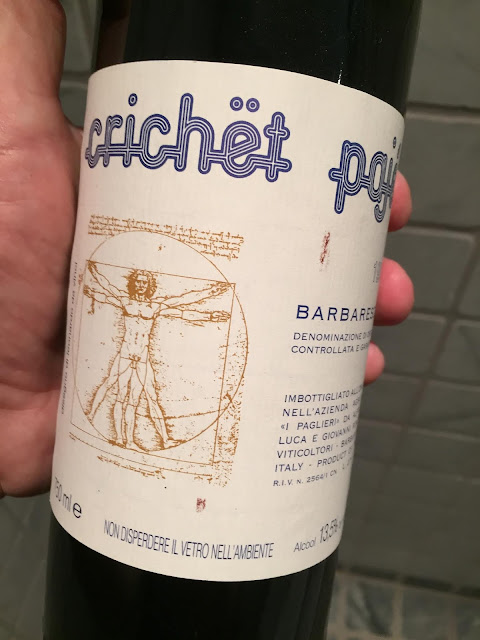1998 Roagna Barbaresco Crichët Pajé, DOCG
I admit to being a Nebbiolophile and in this expensive and highly appreciated top Barbaresco you will find all the expected traditional, and for the Nebbiolo grape typical references to varying degrees; roses, dried cherries, leather, violets and perhaps a hint of tar, but no truffles. This bottle (slow ox’d for 7 hours) was robust, but pure, with floral and mineral notes, opulent but not forceful in any way with splendid tannins present. This is a truly great wine, mature and balanced with great complexity, earthy of course, with an elegant finish with nuances of acid berries and also an inkling of citrus bergamia aromas. This wine is drinking beautifully today IMO, and possibly better than ever? I will enjoy the remaining few bottles over the next couple of years, but perhaps keep one for the long run..
The notes above does not aim at giving the reader a full descripion of this great bottle of Barbaresco, it’s just a muddled summary of my drinking experience. The very act of taking a wine tasting note, of putting into words my sensory experience, does not help me personally to focus more clearly on the wine in question. I prefer to develop an overall impression of the wine while not focusing on the many details. I don’t think that the subtle nuances will pass me without notice — I prefer the wine to come to me, not actively ‘analyzing’ the wine.
1998 is considered a good/great Piedmont vintage. Following spring rains, which caused some rot, a very hot summer growing season and classic autumn brought warm daytime temperatures balanced by cool nights for gradual ripening. 1998 wines were typically refined and silky with moderate acidity for medium to long-term drinking. Harmonious and well balanced in general.
 |
| Wine Bottle Label |
From the Winemaker;
The name Crichet Pajé comes from the Piemontese dialect. When the Italian State was created, each parcel of land was given an official name.The word Crichet is translated as “top of the small hill”. This is our ultimate location for the cultivation of Nebbiolo. The Nebbiolo grape performs best when it is well exposed as well as sheltered from the strongest winds from the tallest hills; Pajé term refers to the vineyard location. Crichet Pajé is a micro parcel located within the same area, which is particularly rich in white calcareous soil and has our highest content of active limestone.
The Paje vineyard is 0.5 Hectare (1.24 Acres) with a unique microclimate and soil which enjoys a view over the Tanaro river valley. The exposition mitigates the cold winters and hot summers. The vineyard is located in the center of the Pajé designated area with additional area facing Southwest. The youngest vines used for this wine are more than 60 years-old with all vines regenerated by using clippings from other vines exclusively located within the same area.In fact, some of the vines have been propagated by using ungrafted vines. The older vines have reached a balance of optimum production even though some plants produce only a single cluster during some years.
This wine is born from the experience over many years by Giovanni Roagna. After purchasing the vineyard in 1953, Giovanni spent many years of experimentation in order to seletec this unique terroir. Over the years this wine was aged for as long as it needed in orer to reach maturity and the wine was saved for the family as well as used for important events. In 1978, Alfredo Roagna decided to present Crichet Pajé to the marketplace for the first time. Crichet Pajé requires long aging in large oak barrels and is introduced to the marketplace approximately 10 years after being harvested. Our family believes this is the ultimate expression of our cellar because we value highly complexity and longevity in our wine. We harvest the nebbiolo fruit manually using small crates during the month of October and usually in the morning, once the fruit is perfectly ripe. We make two passes in the vineyard to select the fruit and ensure its’ integrity. Fermentation takes place for ten days and we use exclusively large wood casks thanks to our pied de cute with our indigenous yeasts. We then follow the ancient technique of maceration by splinting the submerged cap which can last for two and a half months (80–90 days). The wine is then aged in neutral oak barrels.
The production of bottles is extremely small, in some years we produce fewer than one-thousand bottles. The maximum production is just over two-thousand bottles and our larger size bottles of magnums, double magnums, and five liter bottles are even rarer still. We number each bottle.
Further Reading;
I would strongly recommend ‘Barolo and Barbaresco: The King and Queen of Italian Wine’ by the masterful narrator Kerin O’Keefe. O’Keefe gives readers a clear picture of winemaking in this region, including climate change, destructive use of harsh chemicals in the vineyards versus the gentler treatments used for centuries, the various schools of thought regarding vinification and aging, and expansion and zoning of vineyard areas.



Big fan of Barbaresco!
ReplyDelete